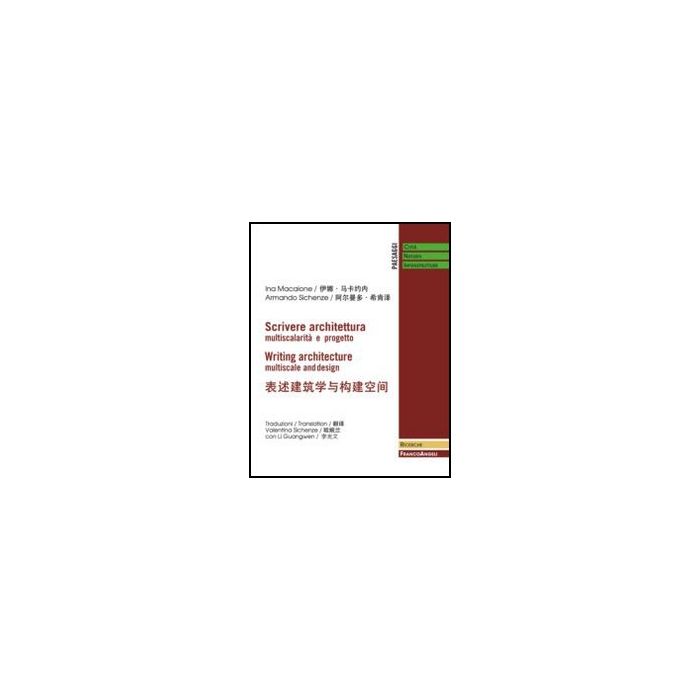Scrivere architettura. Multiscalarità e progetto

- ISBN/EAN
- 9788820431280
- Editore
- Franco Angeli
- Collana
- Paesaggi: citta', natura, infrastrutture
- Formato
- Brossura
- Anno
- 2013
- Pagine
- 240
Disponibile
39,50 €
In un orizzonte di eterotopie di citta-natura l'architettura è lo spessore spazio-temporale del fenomeno in cui appare uno spazio vuoto sensibile di diversa natura. Il libro affronta quest'argomento illustrando lo scrivere architettura nel progetto, presentato come sequenza grafica della ideazione, di volta in volta posta a confronto con brevissime scritture del (e sul) progetto. Si utilizzano, a questo scopo, un centinaio di composizioni di architetture, prodotte negli ultimi 30 anni dagli autori del libro, appartenenti a diverse generazioni.
Maggiori Informazioni
| Autore | Macaione Ina; Sichenze Armando |
|---|---|
| Editore | Franco Angeli |
| Anno | 2013 |
| Tipologia | Libro |
| Collana | Paesaggi: citta', natura, infrastrutture |
| Lingua | Italiano |
| Indice | Introduzione Una fenomenologia architettonica e progettuale Scrivere architettura per creare spazio Architetture di cose che vedono spazi Scrivere architettura (Concept; Progetti di città; Composizioni di edifici per la riqualificazione urbana; Composizioni complesse con principi di città; Composizioni riqualificative con inizi di rigenerazione; Composizioni minimali nell'esistente; Composizioni biocostruttive ed ecovegetative) Indice dei progetti Appendice Maria Italia Insetti, Scrivere sull'architettura nella ricerca progettuale Nicla Maria Notarangelo, Riferimenti bibliografici essenziali Trilingual edition (ITA/ENG/JPN). Big size book (22x27 cm) and with many pictures. What we usually find is that products and technologies are fully shown and described, while the project's ideational processes never are. In this book, instead, they are written in architecture by using the graphic sequences of about a hundred of architectural compositions made by the authors over the last forty years. In this way it is possible to compare the different nature of the empty space which is revealed as a spacetime phenomenon in the last narrative images of each project. Is writing architecture that allows us to minimize headlines and descriptions, always written in Italian, English and Chinese. Ina Macaione (https://sites.google.com/site/macaionematarchitettura/). Born in Palermo, since 2010 she has being working as an Associate Professor in the Facoltà di Architettura dell'Università degli Studi della Basilicata (University of Basilicata's Faculty of Architecture). In the local administration of Matera, she is currently executive councillor for land and construction, for the protection and restoration of landscape, urban quality, architecture and housing politics and for the protection of UNESCO heritage (Sassi and Murgia materana). Her specific research subject is a sustainable development perspective. Armando Sichenze (www.unibas.it/utenti/sichenze/home.html). Born and graduated in architecture in Rome, he took part to several projects and researches on the relationship between architecture and nature-city, both in a national and international field. He has been founder and president of the Organizing Committee of Architecture Faculty of Matera and Coordinator of the International PhD in Architecture and Urban Phenomenology. Contents: Introduction An architecture and design phenomenology Writing architecture to create space Architecture of things that see spaces Writing architecture Works concepts (City designs; Buildings composition for urban requalification; Complex compositions with city beginnings; Requalification compositions with regeneration beginnings; Minimal compositions inside the existing; Bio-constructive and eco-vegetative compositions) Project Index Appendix Maria Italia Insetti, Writing about architecture in design research Nicla Maria Notarangelo, Essential Bibliography. |
| Stato editoriale | In Commercio |
Questo libro è anche in:
